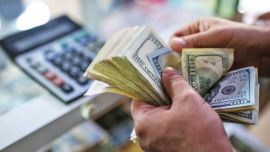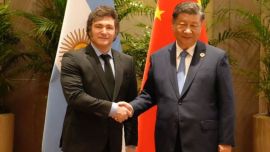Pre-election jitters ripped through Argentina’s currency markets on Friday, weakening the peso in parallel exchange rates and sending the nation’s ‘country risk’ rate soaring.
The ‘blue dollar’ closed out the week at a record high, rising four pesos yesterday to close at 195 to sell, 191 to buy.
On official markets, the exchange rate stood at 104.94 pesos per greenback, limited by longstanding restrictions on the purchase of foreign currency.
The peso has slumped 4.36 percent this week, with a 96.2 percent gap between it and the formal rate, according to Reuters.
Over the previous four days, the so-called ‘dólar blue’ has jumped almost 10 pesos, widening the gap with the official exchange rate and putting pressure on inflation.
The informal exchange market, where the blue dollar is traded, has a low volume of operations but serves as a sensitive indicator of market expectations.
“The mistrust does not stop. There are surplus pesos and there is nowhere to buy formal dollars,” financial advisor Salvador Di Stefano told Perfil on Friday.
Argentina’s ‘country risk’ rate, a measurement tracked by JP Morgan, soared to a new high in the wake of the news, reaching 1,672 points – exceeding its previous ceiling reached in March earlier this year.
Turbulence
The turbulence in the currency markets is a reflection of the uncertainty felt by investors ahead of the upcoming midterm elections. Argentina is due to go to the polls on November 14, with half of the lower house Chamber of Deputies and a third of the Senate up for renewal.
Analysts have been speculating heavily about a potential devaluation of the peso after the elections, which could see the government lose its majority in the upper house.
President Alberto Fernández’s government has had currency controls in place since 2019, with increasingly restrictive measures introduced to limit purchases of foreign currency.
Argentina’s economy, in recession since 2018, is now rebounding after a devastating decline of 9.9 percent of gross domestic product last year, a slump caused in large part by the coronavirus pandemic.
Nevertheless, runaway inflation is continuing to sap away at purchasing power. Consumer prices rose 3.5 percent in September, higher than anticipated, with the annual rate now standing at 52.5 percent. Prices were up 37 percent in just the first nine months of the year.
Earlier this week, the government ordered a 90-day freeze on the prices of more than 1,400 household goods to protect citizens, a measure strongly rejected by the opposition and several business leaders.
According to the latest Central Bank survey of market estimates, the nation’s main consulting firms and specialist economists estimate that inflation will total 48.2 percent in 2021.
Bank of America forecast Friday that Argentina's annual inflation rate would come in at around 50 percent, with GDP expected to grow 7.3 percent by year's end. It said its predictions were "based on an agreement with the IMF finalised before the end of January.
– TIMES/AFP/NA
























Comments